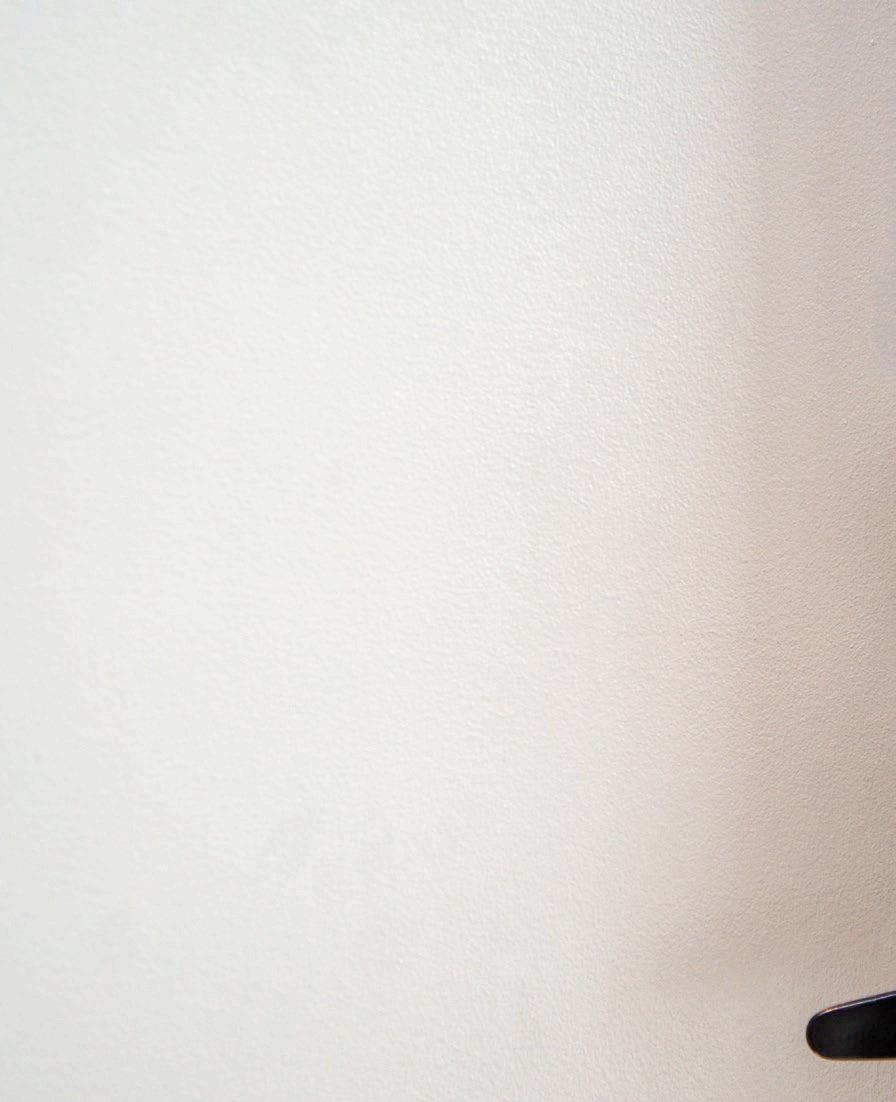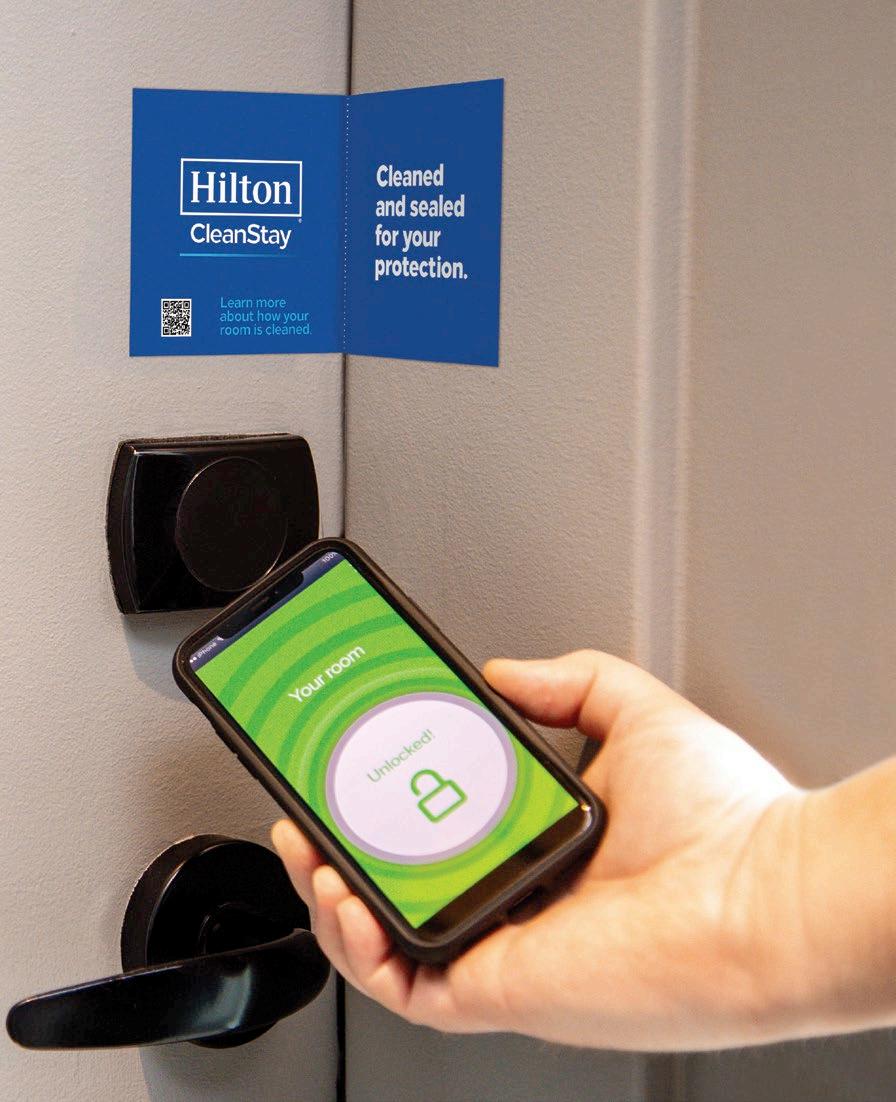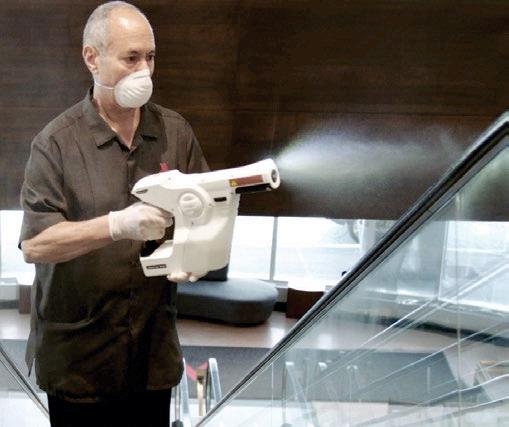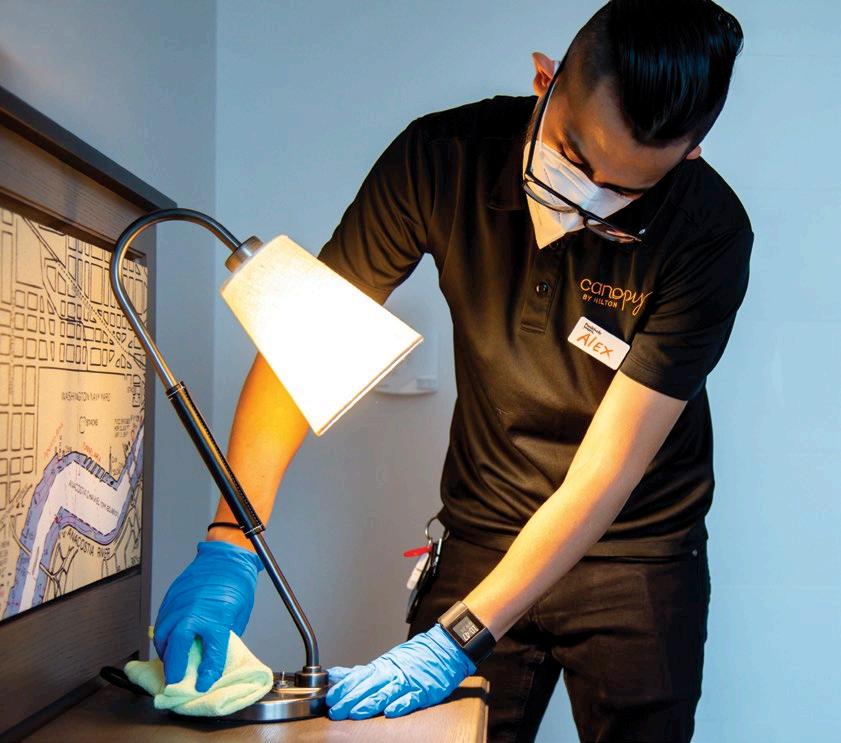
15 minute read
CLEANING UP THE CRISIS
WORDS HANNAH BRANDLER
How hotels have risen to the challenge of keeping guests safe during the pandemic
RIGHT: Hilton CleanStay – cleaned rooms are sealed
BELOW: Accor ALLSAFE T he COVID-19 pandemic has wreaked huge damage on the hospitality industry over the past year, with new strains of the virus creating additional threats at the turn of the decade. Where hotels have been able to stay open, they have had to adapt quickly to new regulations, redesigning spaces and enhancing cleaning to keep guests and staff safe, all the while trying to maintain some kind of revenue stream through initiatives such as “work from hotel” packages.
Guests too have changed their behaviour. Whereas once they may not have thought much about the work that goes on behind the scenes, now travellers prioritise hygiene when booking. According to a survey carried out in the UK and US by Honeywell in December, 48 per cent of respondents said that enhanced cleanliness or health and safety procedures would motivate them the most to stay in a hotel, while 57 per cent of those in the US cited cleanliness as the top deciding factor for choosing which one to book.
Here we explore the new safety measures that have fundamentally changed the guest experience. KEEP IT CLEAN All of the major hotel chains have developed robust new cleaning protocols, reviewing each department and providing staff with comprehensive safety and hygiene training. For many groups this meant consulting external experts on keeping guests safe.
In April last year, Marriott International unveiled its Global Cleanliness Council, a body comprising specialists in hospitality, epidemiology, sanitation and protective health and hygiene technology.
Meanwhile, Hilton partnered with the manufacturers of Lysol and Dettol to launch its CleanStay platform in June, with Alex Humphrey, Hilton’s senior director for safety and security in Europe, the Middle East and Africa, using his experience as a medical microbiologist to steer the group in the right direction.
“The key thing is it’s not just a marketing ploy,” he says. “We approached this with a scientific microbiological mindset. We weren’t like a rabbit [caught] in the headlights.”
Such programmes also tend to undergo external certification and auditing.
Accor’s ALLSAFE scheme, for example, is endorsed by testing, inspection and certification specialist Bureau Veritas, while in the autumn its protocols in the UK and Ireland secured government backing.
Radisson Hotel Group has also signed a global agreement with inspection, verification, testing and




certification company SGS to create a 20-step cleaning and safety protocol for hotels.
At a local level, some groups have appointed ‘COVID officers’ who are responsible for making sure that individual properties adhere to guidelines.
Accor has trained ALLSAFE Ambassadors, IHG Hotels and Resorts’ ‘clean champions’ instil a “culture of clean” across its portfolio, while Hyatt ensures that every hotel globally has a trained hygiene and wellbeing leader.
Meanwhile, health and security companies such as International SOS have provided support to the likes of Four Seasons and Oakwood. It sends medical directors to test out the user experience and compile comprehensive reports with recommendations for select properties.
STEPPING IT UP So, what do these programmes entail? Each varies slightly and is tweaked to meet regulations in different parts of the world but, by and large, the groups have a similar approach to hygiene. First and foremost, traditional cleaning measures have been stepped up. In public areas, high-contact surfaces such as reception counters, lift buttons, door handles, bathrooms, stair handrails and gym equipment are cleaned more frequently with hospital-grade disinfectant products, while sanitising stations have also been set up.
In guestrooms, high-touch areas such as door handles, taps and light switches are also receiving special attention, while groups such as Accor are promising deep cleaning of upholstery and carpets and hightemperature washing of bedding. Many chains also provide disinfecting wipes in each room for guests’ use.
While much of this work remains invisible, Hilton reassures guests by attaching a CleanStay room seal label to guestroom doors to show that no one has entered since housekeeping. “That helped to reduce anxiety and give great customer confidence,” says Humphrey, who previously worked for the UK’s National Health Service (NHS) as an infection control adviser. Rooms may also include cards detailing the cleaning procedures in place at the property.
Housekeeping itself has changed, with some guests wanting a full service and others preferring that no one else enters during their stay. Rooms are thoroughly disinfected between stays but it is then up to guests to choose the frequency of service. According to Honeywell, 93 per cent of respondents who had stayed in a hotel since March 2020 reported a positive experience regarding safety and cleanliness. Humphrey reports that Hilton’s measures have “gone down an absolute storm” with customers,
while Richard Short, Accor’s health, safety and environment director for Northern Europe, encourages guests to shape the future of the hotel experience by providing feedback. “We invite guests to join us on this journey because we all have the same motives. We don’t want this virus to spread uncontrollably,” he says. SPRAY IT AGAIN While traditional cleaning methods are effective, some hotel groups have gone even further, using advanced technologies such as electrostatic spraying. Marriott deployed this in the public areas in properties across all brands in its portfolio. It works by applying an electric charge to hospitalgrade disinfectant, enabling it to cover a surface more effectively than conventional methods. The rollout was not a simple endeavour – research was undertaken to discover how often it could be used, the consequences of inhaling the fumes, and how heavy the sprayers were.
“Like anything that’s new, you want to make sure it’s safe and that you’re not inadvertently causing harm”, Arielle Quick, Marriott’s chief continent lodging services officer for EMEA, says. THE HUMAN ELEMENT While such methods play their part in stopping the virus in its tracks, it’s human behaviour that is most important. The World Health Organisation warns that person-toperson contact is the main way to spread COVID-19, meaning technology is rendered obsolete if basic elements such as hand hygiene, face coverings and social distancing are not observed.
As Dr Rodrigo RodriguezFernandez, global medical director of non-communicable disease and workplace wellness for International SOS, puts it: “I can have the best and most expensive air purifier system, but if people are not following the rules then it doesn’t really matter.”
Short agrees that “it’s important to use the tried and tested methods”, while Tom Flanagan Karttunen, Area Senior Vice President for Northern and Western Europe at Radisson Hotel Group, states the firm “didn’t feel the need to bypass the more practical implementations of simple cleaning and disinfecting”.
Properties have therefore reconfigured public areas to allow for social distancing, as well as introducing signage and making mask-wearing in public areas mandatory.
Front desks may have Perspex partition screens for added protection, and one-way systems are often in place, with separate entrances and exits. Leisure facilities such as gyms and spas may be closed or limited in terms of guest numbers. Some hotels are also using thermal screening and temperature guns to pinpoint instances of the virus.
So, what happens in the case of a suspected or confirmed case of COVID-19 on-site? First, the hotel will make sure the individual is safe and quarantined. It will then notify local authorities and follow recommended measures on next steps.
Following the guest’s departure, the room will be isolated for 72 hours and then deep cleaned. The good news, according to Rodriguez-Fernandez, is that there is little risk of contaminating other people as most chain hotels have excellent ventilation.
CLOCKWISE FROM
BELOW: Marriott’s electrostatic spraying; ALLSAFE Ambassadors; Marriott uses hospital-grade disinfectants; An IHG ‘Clean Champion’


TOUCH-FREE TECH The pandemic has accelerated the adoption of contactless technology enabling travellers to control their stay from mobile devices. Apps are increasingly being introduced for guests to check in and out remotely, order room service and amenities, speak with staff using instant messaging and make special requests.
For a few years now, Hilton, Marriott and Hyatt have offered secure digital keys to loyalty scheme members, allowing them to bypass the front desk and unlock their doors using their phones. The global roll-out of this technology, however, has been sped up as a result of the pandemic.
As of December 2020, Hilton guests had used the digital key to open more than 100 million doors worldwide, with 80 per cent of the group’s hotels now equipped with the technology. Hyatt, too, reached a critical milestone in its contactless journey, with more than 500 properties using digital key by the end of last year.
Meanwhile, more than 4,100 hotels within Marriott International’s global portfolio have a mobile key technology; half of its EMEA hotels are now live with the technology, with many more signing up this year.
Accor followed suit in January this year, partnering with mobile key tech provider Stay My Way to launch the technology at selected properties in North America, Europe and Asia – the group says that the service will be rolled out to 500 properties by the end of 2021, and at least 50 per cent of its portfolio within the next five years.
Low-touch travel is clearly here to stay – still, hotel groups are adamant that this is not at the expense of hospitality.
Humphrey cites how Hilton team members across the group have adapted their service during the pandemic, adopting different gestures to showcase their hospitality – one example is staff placing hands on their heart and using expressive eyes when interacting with guests.
“I’ve been bowled over by how our teams have adapted to these new gestures of hospitality,” he says. FOOD AND DRINK Whether you’re staying at a budget hotel or a luxury resort, you’ll notice how hugely food and drink services have been affected by the pandemic. Restaurants may be shut, transformed into takeaway outlets or had their menus streamlined to simplify operations and cut costs. Regulations differ in each territory, with individual properties having to comply with local policies.
Where restaurants remain open, they have been rearranged to create more space between tables and introduced disposable or laminated menus or QR codes for accessing them online.
Buffet-style service has survived in some hotels after being adapted for the new era, with cooked food served by staff and guests able to pick up prepackaged items.
As Marriott’s Quick puts it: “People love the hotel buffet. As operators and hoteliers, we want to keep our guests safe, but we also want to provide an experience that feels luxurious or special.”
Restaurants may also separate teams who touch equipment before or after it has been in contact with customers, as Hyatt does.
WHAT THE FUTURE HOLDS Following a year of – yes, that word – unprecedented scenarios, it’s perhaps futile to try to forecast the future. Still, thanks to the rollout of approved vaccines, there is hopefully an end in sight.
Discussions are ongoing regarding the deployment of “vaccine passports”, apps that keep record of travellers’ vaccination and negative COVID tests, and the ethical implications of allowing businesses to demand proof of vaccination from their customers.
Would hotels use such technology? Flanagan Karttunen says he welcomes such passports “to aid and generate more international travel, which is desperately needed”, but disagrees with the use of such technology as a condition of stay, adding that “it wouldn’t be correct” due to the discriminatory element.
While it is highly unlikely that hotels will accept vaccinated guests only, they may ask for proof of a negative test result.
“[Rapid testing] is the one [thing] that will probably change the face of the hotel industry and travel in the next couple of months and how we return to some degree of normal,” says Rodriguez-Fernandez.
Indeed, Radisson is already looking into offering rapid testing as a service for people who book meetings at its hotels.
If there is any silver lining to come out of all of this, it is that “every


company has become a healthcare company”, Rodriguez-Fernandez adds.
“Never before have we seen conversations about health in a nonhealth sector company. Our hope is that this will remain, even when COVID-19 goes away.”
Indeed, Accor has partnered with AXA to provide guests with free 24-hour access to telemedicine consultations across its global portfolio of more than 5,000 hotels.
This partnership is not COVID19-specific and will continue beyond the pandemic. Radisson has also looked beyond COVID, partnering with a crisis management company to prepare itself for the long-term impact of the pandemic. The crisis has generated a series of new trends, notably the rise in remote working lifestyles. “One very cool trend that comes out of the pandemic is that hotels need to cater for people who are no longer trapped to an office environment”, explains Flanagan Karttunen, who typically travels 50 per cent of the year.
Groups are looking into how public spaces will evolve in the future, and how they can cater to this new market, whether that be through hybrid rooms with office-style facilities or coworking areas.
There are difficult times ahead, but “hospitality is a resilient industry and has proven to be so time and again”, says an upbeat Srdjan Milekovic, Hyatt’s senior vice-president of operations for EMEA.
“While the industry is in a tough position now, we know it will recover,” he continues.
The group recently announced plans to grow its footprint in Europe by more than 30 per cent.
“We know that there is pent-up demand for travel and once our guests and members are ready to do so again, we will be ready,” he says. “We’re patiently looking forward to it.”
ABOVE: Hilton has teamed up with Lysol and Dettol LEFT: Accor has partnered with mobile key tech provider Stay My Way

WORDS HANNAH BRANDLER


2 London
This bustling transport hub in the centre of London has plenty of options for eating, drinking and exploring
1 GRAND UNION CANAL Exit Paddington station via South Wharf Road and turn le into the cobbled pedestrianised street that runs alongside St Mary’s hospital. Follow the sign to the right for Paddington Basin and snake around the building until you reach the Grand Union Canal.
Stretching 136 miles from London to Birmingham, it was once a major artery for bringing goods and freight to the capital from the Midlands and the North. Today, Paddington remains an important transport hub, as the London terminus of GWR and a future Crossrail station – but it has also invested in a cultural future.
More than $1.3 billion has been spent on regenerating the neighbourhood, transforming the banks of the canal into a lively area buzzing with restaurants, bars and community spaces, while its waterways have become tourist attractions.Head to the year-round Floating Pocket Park at Merchant Square – overlooked by glass and steel buildings. is lush green space was created by garden designer Tony Woods. It o ers respite from the industrial architecture with its series of lawns connected by decked platforms, walkways and plenty of bench seating amidst oral planters.
2 GO BOAT Take a break from London’s Tube and rail rides and instead cruise down the canal in one of Go Boat’s electric self-drive vessels. Starting at the pontoon at Merchant Square, you’ll be able to visit the likes of Regent’s Park and Camden Lock with up to eight people (depending on current government “bubble” guidance). Fret not, you won’t need any captain experience as a member of the crew will run through the controls before you set o .
On your travels you’ll pass the omas Heatherwick-designed Rolling Bridge on your right, an octagonal structure that unfurls across the towpath every Wednesday and Friday at noon, and on Saturdays at 2 PM. From £79 ($102) for one hour; online booking only.
goboat.co.uk
3 LITTLE VENICE Once you’ve safely returned the boat in one piece, turn right into Hermitage Street and continue
Paddington


4 3

5

through a tunnel under the Westway, stopping to appreciate ceramicist Robert Dawson’s wall mural. e blue-hued tiles pay homage to the area, featuring a pattern based on the Crossrail logo and a portrait of Isambard Kingdom Brunel, the engineer behind the network of tunnels, bridges and viaducts for the Great Western Railway founded in 1833, approved by Parliament in1835 and ran its rst trains in 1838.
Turn le down St Mary’s Terrace until you reach Maida Avenue. You’re now in the heart of Little Venice, one of London’s most coveted residential areas, famed for its Regency white stucco villas and quaint houseboats along Regent’s Canal. Walk le and cross over to the peaceful Rembrandt Gardens for leafy views of the waterways and narrowboats.
4 DARCIE AND MAY GREEN Now that you’ve worked up an appetite, head back to the Paddington arm of the canal to experience one of its many eateries. Highlights include Darcie and May Green, an Antipodean restaurant housed in a barge on the canal. is oating and popular hangout could easily be mistaken for an art installation, with its colourful façade designed by Sir Peter Blake – creator of the Beatles’ Sgt Pepper’s Lonely Hearts Club Band album cover fame – and its 165-footlong upper deck is a prime spot for people and canal-watching.
Another option is London Shell Co, which runs seafood cruises aboard the Prince Regent, o ering set menus for lunch and dinner. If you’re prone to seasickness, its neighboring sister restaurant, the Grand Duchess, is safely moored on land.
daisygreenfood.com; londonshellco.com
5 PERGOLA PADDINGTON End your eeting visit with a welldeserved aperitif. From Darcie and May Green and London Shell Co, take a le turn into Sheldon Square and then continue on to Kingdom Street until you reach Pergola Paddington. is picturesque, partially open-air food court is set over two oors and is clad in a leafy canopy of owers and fairy lights. It has four self-service street-food vendors that change seasonally, plus two bars, daybeds for lounging, and weekend DJ sets.
pergolapaddington.com
2









